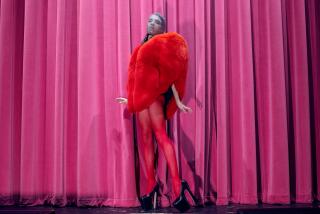The Fabric of Their Lives
Some families have the grandfather clock. Others have the set of monogrammed silver. Mary Elizabeth Kelly and her family have The Dress.
Over the years, the dress has been dined in and danced in, cuddled in and cried on. It’s been tugged at, twirled in, talked about and revered, even sprinkled with holy water. Fifteen times in 52 years, the dress has transformed a girl as she solemnly stepped down a church aisle, rosary beads in hand, a lace veil on her head.
And it has survived. Unsullied. Unspoiled. Unimaginably valuable to each who has worn it, if only for a day. Over time, the dress, a hand-stitched pouf of white cotton eyelet batiste, has come to represent the very fabric of one profoundly devout family’s life.
In its first incarnation, it enrobed a Philadelphia bride. The bride was the daughter of Mildred Burns, who sewed it in 1948, never realizing that her skill and frugality would provide such a legacy.
Burns, a nurse during the day, spent four hours a night for two months working on the garment, turning eight yards of the French fabric into a wedding gown for Mary, then 22. Mary had designed the floor-length dress, with its tight bodice, low waist and flare at the hem. Mary didn’t want a train . . . but she did dream of a beaded Juliet cap and veil, which her mother also made.
On Sept. 11, 1948, Mary wore the gown to wed Thomas Kelly. They would, over time, become the parents of seven girls and five boys. Three years after the wedding, when the couple moved from Philly to Long Beach, Mary left the gown behind.
For years after that, in phone conversations, Mildred asked her daughter what she wanted to do with the dress. Mildred was meticulous about such matters, a no-nonsense, Mary Poppins kind of woman who’d lived through the Great Depression and knew a thing or two about thrift. She was known to read a letter twice, then throw it away because she refused to clutter her house. Knickknacks were a no-no; dust collectors, she’d say. In fact, Mildred didn’t waste a thing--not time, or patience, or food. And certainly not money--especially when it came to clothing.
So when her daughter called in a panic, needing a dress for her 7-year-old daughter’s communion, Mildred knew exactly what to do. She brought out her daughter’s wedding dress from the cedar chest in which it had lain, untouched, for nine years.
And she took her shears to it.
Wedding Gown to ‘Cinderella Dress’
Days later, a box tied with string arrived at Mary’s door. Mary gasped when she opened it. Her low-waisted, floor-length size 12 dress with its high, round neck and long pointy sleeves had been altered. It was now a confection for a little girl--with a lace-edged Peter Pan collar, short puffy sleeves and full skirt set off by a soft, wide sash at the waist. Mary could barely get it over her head.
“I didn’t cry about it,” she says. “I was appreciative. I was happy because I needed the dress and there it was right in front of me. My mother had made up my mind for me, thank you, God. Amen.”
And so Mary Kelly Stabile, named for her mother, became the first granddaughter of Mildred Burns to wear the dress. She, too, remembers the day in 1957 that it was delivered to the front door. She had just arrived home from St. Cornelius Catholic School in Long Beach. As her mother gasped, all she could think was, “Wow, my Cinderella dress!”
Her six younger sisters--Colleen, Karen, Jane, Denise, Grace and Frances--would wear it too. As would, in time, seven of their daughters.
More than anything, the women of this family marvel at how a single garment has bonded three generations and how Mildred, who died of heart disease at 74 in 1982, had unwittingly created a priceless heirloom, a hand-me-down that her seven granddaughters and another seven great-granddaughters have worn for their holy communions.
The dress has come to mean more “than just something pretty to wear,” says Mary Kelly as she reaches for the garment. She holds it, smells it, hugs it to her chest. The dress, she says, unleashes a lifetime of memories--her life, her daughters, her granddaughters--a scrapbook unfolding before her eyes.
Now 73, she is chatting with her daughters Colleen Derham, 47, and Jane Luppi, 44, and several granddaughters who have stopped to visit the gift shop she and her husband have owned in Tustin for 29 years.
Just thinking about the dress, says Colleen, takes her back to other childhood family traditions: a doughnut-eating game they’d play with their father on Sundays, the turkey trophy he’d hand out for the best Thanksgiving speech. Mostly, though, it reminds her about what it was like to grow up in a family with six sisters and five brothers “where there was always someone to play with.”
All of Jane’s girls--Elizabeth, 17; Cecilia, 13; Kathleen, 11; Monica, 10, and Grace, 8--have worn the dress, aware of its significance through the family’s tradition of storytelling.
“Every time one of my girls wore the dress, my own childhood feelings came flooding back,” Jane says. She mostly remembers “how my parents were proud to take their 12 kids everywhere. My mother would say, ‘If you don’t take the children how will they ever learn?’ If my parents couldn’t take their kids, they’d turn down the invitation. Family always meant the world to them.”
Her daughter, Elizabeth, a senior at Aliso Niguel High School, was the first of Mildred’s great-granddaughters to wear the dress. Elizabeth points to a photo of herself in it. “I know I’ve had a different outlook on life because of the dress,” she says. “I’ve learned to cherish things in the family that are important. It’s all about love.”
After Elizabeth, came her sisters and 10-year-old cousins Leanne Kelly and Mary Elizabeth Kelly. Last year, the dress was worn by a different girl on three consecutive weekends.
It survived the whirlwind with everyone making sure spaghetti didn’t get spilled on it. “We’re always watching the dress,” says Elizabeth, “making sure the girls don’t play in the sand with it on.”
The dress has never been sent to the cleaners for fear of it being damaged. Instead, it has always been washed by hand, drip-dried, then ironed on a low temperature. When it’s not in use, Jane is the keeper of the dress. “Jane is sentimental like that,” says her sister, Colleen.
The second generation of girls to wear it for communion say they have gladly continued the tradition. And each confesses that she could hardly wait to put on the dress--which has never been ripped or stained. They also love bragging to friends that the dress was once their grandmother’s wedding gown.
“Boy, your grandma must be a tiny lady,” Leanne says her friends will reply. It’s a comment all who have worn the dress have heard, and one they love to joke about with their grandmother.
Leanne’s younger sister, Rose, 7, is next in line to wear the dress. And like every girl before her, she’ll wear a handmade lace veil, imported from Ireland, which will be her keepsake of the sacred occasion.
After Rose come Mary Kelly’s other granddaughters, Claire Baltes, 5; Sarah McKenzie, 2; Catherine Baltes, 7 months, and Caroline Kelly, 3 months. And maybe another granddaughter--if Mary Kelly’s youngest daughter, Frances McKenzie, who is expecting on Christmas Day, has a girl.
Frances, 35, who lives in Pennsylvania, vividly recalls the day in 1972 when she took her turn in the dress at her morning communion Mass, which took place on a school day. After the ceremony, she rushed her parents through brunch so she could get to school. When she walked in, she says, “I felt like queen for a day.”
As meaningful as the dress has been for the Kelly women, it holds fond memories for the men of the clan, too.
When his daughter, Leanne, wore the dress last year, Jim Kelly couldn’t fight back the lump in his throat. “Leanne’s face was just beaming, you know,” he says. Seeing his daughter in his grandmother’s handiwork, sparked feelings inside him about the importance of family, a sentiment shared by all.
“The dress represents the hope of the future as much as it has represented the past,” says Denise Magro, 41, who was in the second grade when she wore it in 1966.
Thomas Kelly, 74, agrees. “When I see one of my granddaughters in the dress, it strengthens my faith,” he says. “I get this warm feeling inside me. It conveys the memory of my whole life pretty much.”
For Mary Kelly, the dress rekindles loving memories of her parents, her faith, her childhood in Philadelphia, her life here.
“My whole life flashes in front of me,” she says, her eyes on the dress, then on her daughters, then on her grandchildren seated around her. “I get choked up. All the time.”
Several years ago, Mary Kelly was asked how much the dress cost to make. Put a price tag on the dress?
“I could never measure that dress in money,” she says. “I measure it in love.”
*
Michael Quintanilla is at michael.quintanilla@latimes.com.






